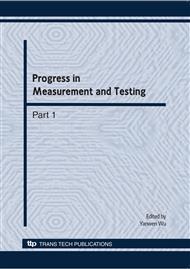[1]
D. Calvetti and L. Reichel, Tikhonov regularization of large linear problems, BIT Numer. Math. 43 (2003) , pp.263-283.
Google Scholar
[2]
C. Ramanathan, P. Jia, R. Ghamen, D. Calvetti and Y. Rudy, Noninvasive electrocardiographic imaging (ECGI): application of the generalized minimal residual (GMRes) method, Ann. Biomed. Eng. 31 (2003) , pp.981-994.
DOI: 10.1114/1.1588655
Google Scholar
[3]
M. Jiang, L. Xia, G. Shou and M. Tang, Combination of the LSQR method and a genetic algorithm for solving the electrocardiography inverse problem, Phys. Med. Biol. 52(2007), pp.1277-94.
DOI: 10.1088/0031-9155/52/5/005
Google Scholar
[4]
V. Vapnik, The Nature of Statistical Learning Theory, Springer-Verlag, New York, USA, (1995).
Google Scholar
[5]
S. S. Keerthi, Efficient tuning of SVM hyper-parameters using radius/margin bound and iterative algorithms, IEEE Transaction on Neural Networks, 13(5) (2002), pp.1225-1229.
DOI: 10.1109/tnn.2002.1031955
Google Scholar
[6]
A.J. Smola, B. Sch¨olkopf, A Tutorial on Support Vector Regression, Statistics and Computing 14(2004), pp.199-222.
DOI: 10.1023/b:stco.0000035301.49549.88
Google Scholar
[7]
F. E. H. Tay, and L. Cao, Application of support vector machinesin financial time series forecasting, Omega, 29(4) (2001), pp.309-317.
DOI: 10.1016/s0305-0483(01)00026-3
Google Scholar
[8]
K. Duan, S. S. Keerthi, and A. N. Poo, Evaluation of simple performance measures for tuning SVM hyperparameters, Neurocomputing, 51(4) (2003), pp.41-59.
DOI: 10.1016/s0925-2312(02)00601-x
Google Scholar
[9]
C. C. Chang and C. J. Lin. LIBSVM: a library for support vector machines, 2001. Software available at http: /www. csie. ntu. edu. tw/ ~cjlin/libsvm.
Google Scholar
[10]
L. Xia, M. Huo, Q. Wei, F. Liu and S. Crozier, Analysis of cardiac ventricular wall motion based on a threedimensional electromechanical biventricular model, Phys. Med. Biol. 50, pp.1901-17, (2005).
DOI: 10.1088/0031-9155/50/8/018
Google Scholar
[11]
H. D. Simms and D. B. Geselowitz, Computation of heart surface potentials using the surface source model, J. Cardiovasc. Electrophysiol. 6, pp.522-31, (1995).
DOI: 10.1111/j.1540-8167.1995.tb00425.x
Google Scholar
[12]
M. F. Jiang, L. Xia, G. F. Shou, Q. Wei, F. Liu, and S. Crozier, Two Hybrid Regularization Frameworks for Solving the Electrocardiography Inverse Problem, Phys. Med. Biol., vol 53, pp.5151-5164, (2008).
DOI: 10.1088/0031-9155/53/18/020
Google Scholar


